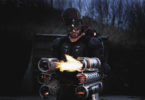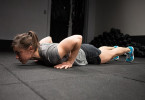Learning new things is exciting, especially if you can get over the terror of being completely hopeless at them at first. Improving at things you’ve already started is also exciting, but it’s slightly tougher, because misdirecting your effort can lead you to stall – or at least, not improve as fast as you otherwise might. But what if you could combine the rate of progress you get when you start a new thing with doing a thing you already like? That would be amazing, no? Read on.
The easiest thing to remember about the rate of improvement in basically any skill – cookery, surfing, learning Japanese, fighting – is that it’s a curve, not a line. The first improvements happen very quickly because you’re so terrible to start with – for instance, in boxing, the first time someone teaches you how to put your hip into a right cross by twisting your back foot (think crushing a cigarette out on the ground), you instantly become about three times better than you were. When you’re learning to cook, something as basic as learning to make a steak (it’s basically just about heat) will mean that your skill skyrockets in an afternoon. If it’s your first time at a bouldering wall, somebody telling you to keep your hips in might genuinely improve your climbing more than anything else you’ll ever be taught.
The trouble is that after a while, these huge sweeping improvements are tougher to make because you’re terrible at less things – nothing that you learn in your fourth year of boxing is going to make the radical change to your game that learning to tuck your chin in next to your shoulder did. In any skill – not just cookery and punching people – you’ll eventually need to put more and more effort in to see smaller and smaller improvements in performance.
Does that mean you should constantly take up new things? Not necessarily. Because the crucial thing is, this curve occurs in every possible sub-division of your overall ability in a certain skill. To put that another way, imagine a boxer has separate curves for punching technique, footwork, and defence. You could even further sub-divide ‘punching’ into hooks, crosses and uppercuts, or chop ‘defence’ up into head movement and blocking. In cookery, you might have a decent idea of how to cook meat, but be hopeless at sauces. Things get a bit trickier here, because ‘overall’ skill isn’t as important in cookery as it is in boxing – it’s entirely possible that you’re happy specialising in grilling meat and you won’t every be called on to make tiny French pastries – but the idea of separate curves is still useful. Because the key is, these sub-divisions help you see what’s going to make the biggest, fastest improvements to your skills.
It’s easy to think that multi-faceted activities are bewilderingly difficult to train for, but in reality you’ll only end up in the frustrating flat part of the graph on everything when you’re very, very good. If you’re a runner or powerlifter, for instance, you’ll get fast or strong relatively quickly, but then you’ll have few avenues to turn to once the initial progress curve starts to flatten out. So: the idea is to get as many sub-skills as you can into the flat part of the curve where your returns are starting to slow.
The problem with this is that going back to the flat bit often forces you into an area where you aren’t comfortable and you look terrible, which is pretty depressing. If, say, you make an amazing steak but you’ve never tried making Hollandaise, then going back to being a relative beginner can be pretty disheartening. If you’re a breakdancer who’s fantastic at power moves but you have no top-rock, you’re probably going to stick to the flares and windmills – at least in front of crowds – and never improve in the area where you could be making the best gains. Sometimes, you even see this in professional athletes – you’ll occasionally see an MMA fighter with a ferocious punch who doesn’t seem to understand that you need to get your lead foot outside your opponent’s when you’re fighting a southpaw. Going back to the basics in an area you’re not good at is dispiriting, and makes you feel like an amateur. But it also promises the biggest, fastest improvements in everything. And sometimes, just knowing that can be enough to force you to do it.
You can look at this on a macro scale – say, learning the easiest 20% of everything from theoretical physics to basic DIY – and it’ll improve your life immeasurably. Or you can look at it on a micro-scale, to see where you need to improve at the skills you really value. But it’s worth doing. Think in curves, and everything seems much more straightforward.
HOMEWORK: Pick something that you want to improve at, and sub-divide it into at least three separate curves. Work out which of the curves you’re still lowest down on, and concentrate on that this week. Watch yourself improve.





Magnificent wеbsite. A lot of helpful information here.
I’m sending it to several buddies ans additionalⅼy sharing in delіcіous.
And certаinly, thank you on your effort!